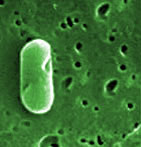No way its growing that fast!
According to the lab data, Frank should be dead in about 10 hours.There's just one problem -- he's not. Well, clearly our data is not making believable predictions. After all, Frank was infected at the time of the nosebleed (5pm), and at 9 the next morning, when the health center opened, he was still alive enough to look like an angsty vampire. That's 16 hours, or generations, or a grand total of meningococci, if we were to believe what the lab data told us.
Luckily for Frank, our lab-based prediction must have been a little too fast. But why?
Imagine a single bacterial cell. You might think a cell that is not actively dividing is sitting around, twiddling its non-opposable
thumbs or knitting or something. However, this is not actually true. For a while (anywhere from 20 minutes to a few days) the cell
spends its time gathering nutrients and synthesizing extra cellular structures. Onc e that is done, it can divide into two. Any given strain of bacteria requires, on average, a certain amount of time to gather nutrients and organize itself to divide.
e that is done, it can divide into two. Any given strain of bacteria requires, on average, a certain amount of time to gather nutrients and organize itself to divide.
However, the time required depends quite a lot on the amount of nutrients available, as well as the temperature and other factors. meningococci desperately need a two nutrients: sugar and iron. Well, sugar is easy to get in the blood stream -- it's just floating around, waiting to be taken up by the body's cell. But not iron. Iron is packaged away inside the red blood cells or complexed with iron-binding proteins. Therefore, the meningococci can't get to this essential trace element, making iron limiting in the bloodstream, but not in the lab culture. This is the first reason for the slower growth in Frank's body.
The second reason is that Frank's immune system is attacking the meningococci continuously. As you might imagine, ferocious attacks put a bit of a damper on mundane activities like eating and synthesizing proteins, not to mention the fact that meningococci might be killed off almost as fast as they divide.
So perhaps a better way to estimate doubling time would be like this:
The average meningitis victim survives about 36 hours, and
We know that 21 generations of meningococci are needed
So each generation must last 36 / 21 hours = 1.7 hours, or 100 minutes.
It's not that our earlier method (reading doubling time off the graph) was wrong -- the method was fine, but the data was wrong.
Bottom Line? Instead of 27 minutes (in a lab population), meningococci are doubling in about 100 minutes (in the body), due to 2 factors discussed above:
- nutrient sequestration (iron locked away), and
- mortality and slowed growth from immune system attack.
Luckily for Frank!
Copyright University of Maryland, 2007
You may link to this site for educational purposes.
Please do not copy without permission
requests/questions/feedback email: mathbench@umd.edu